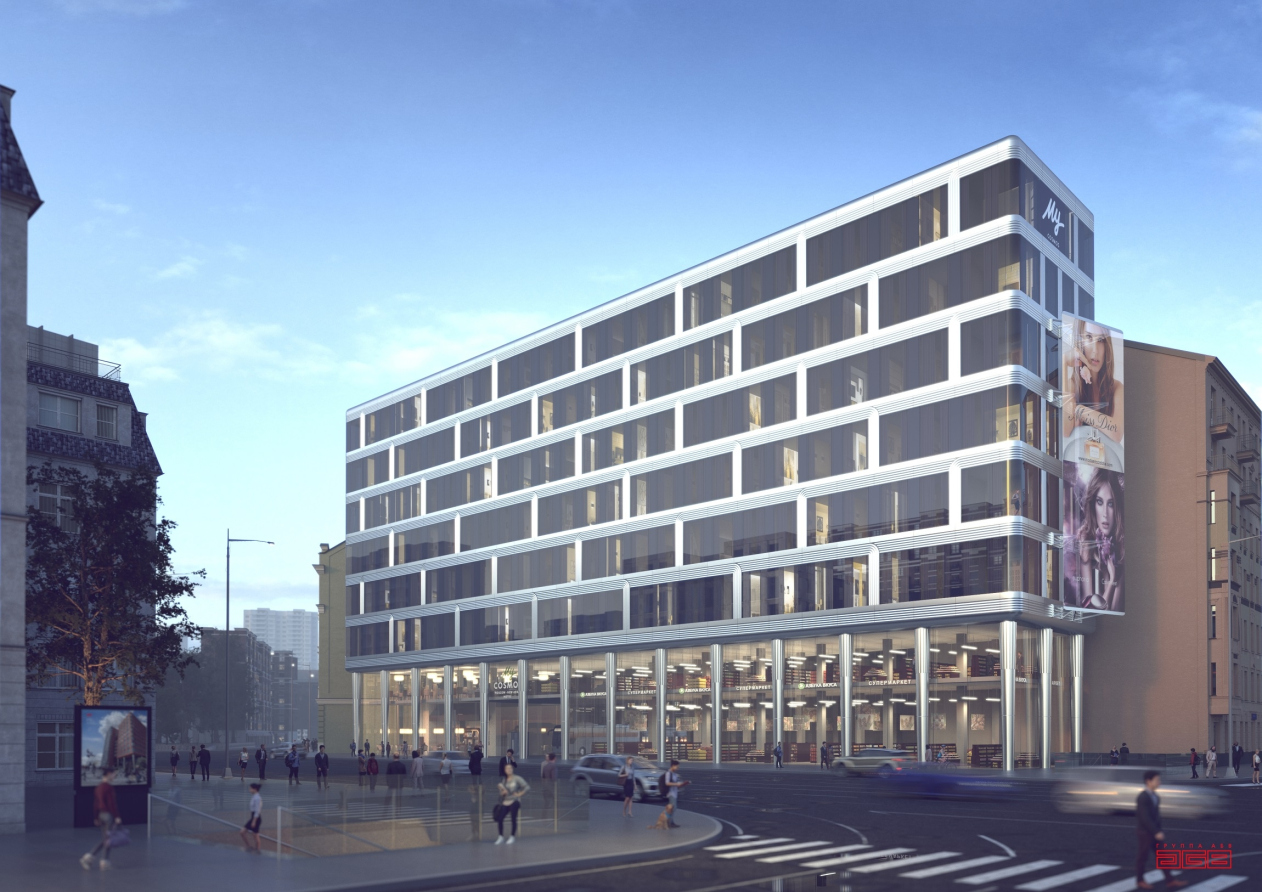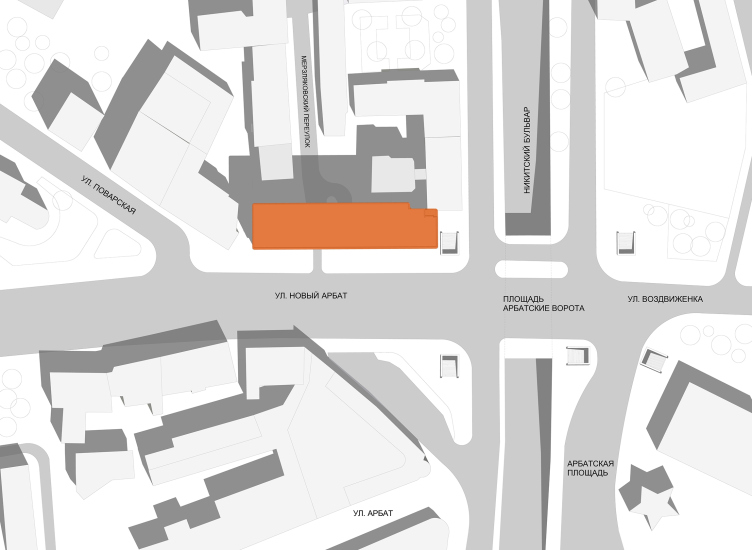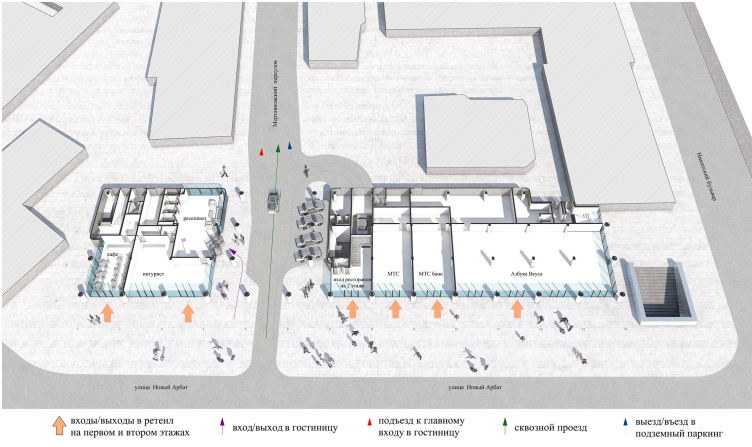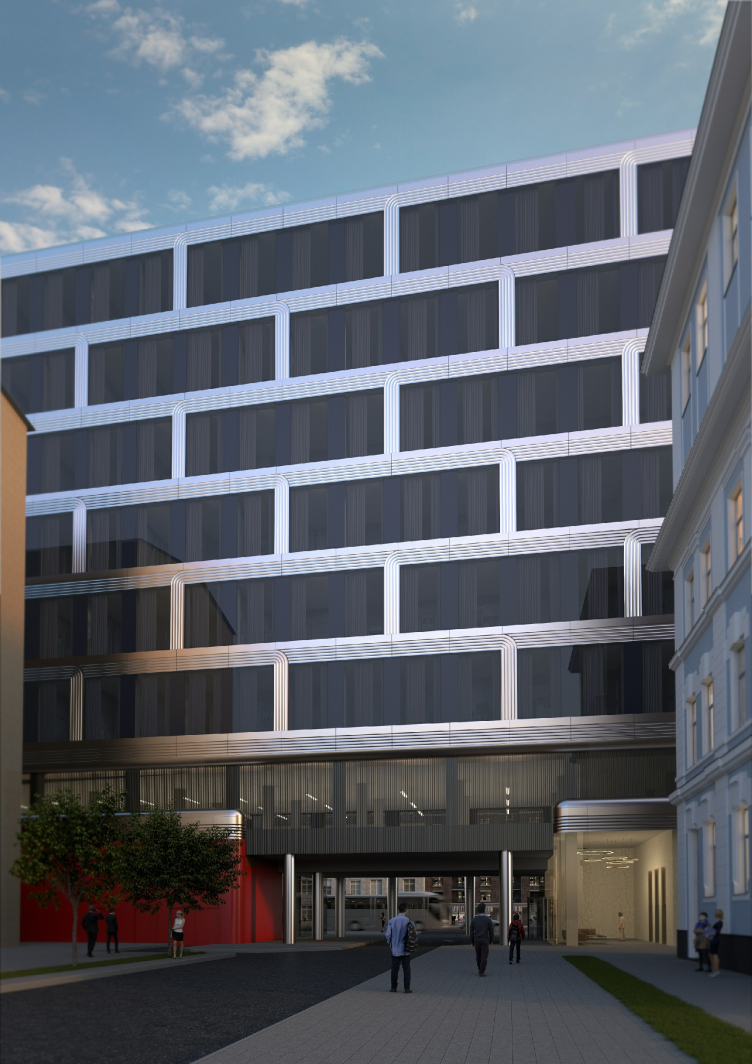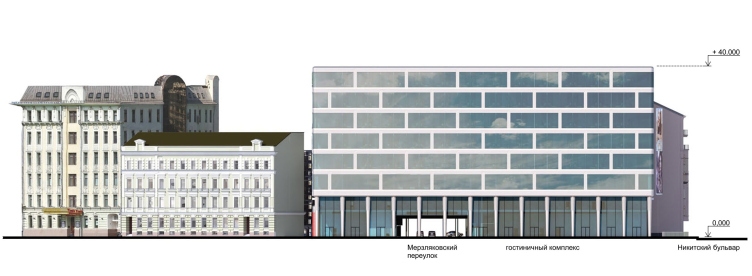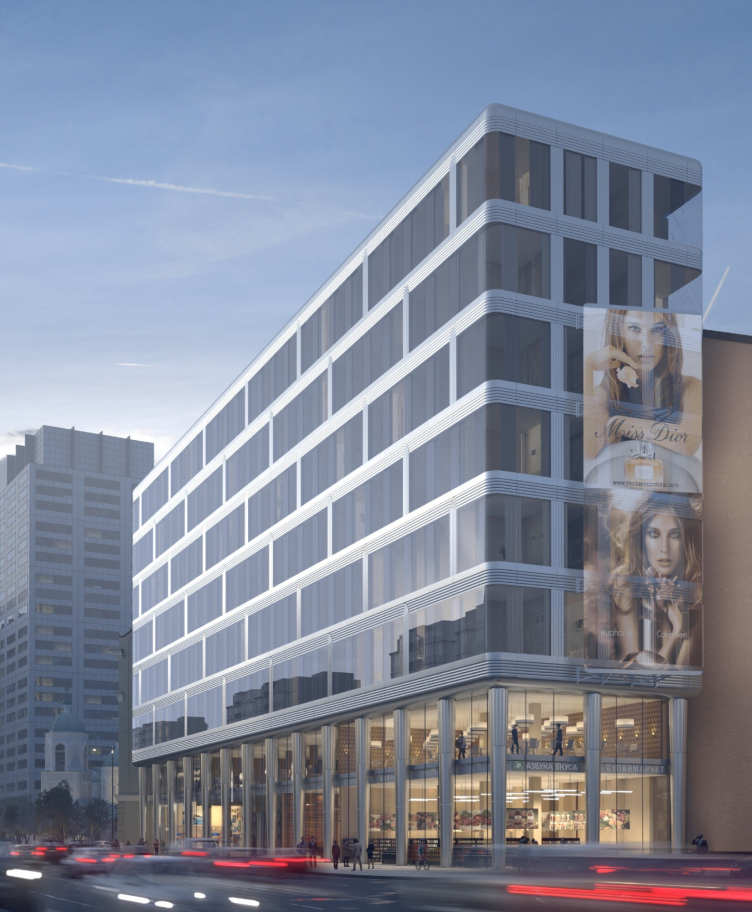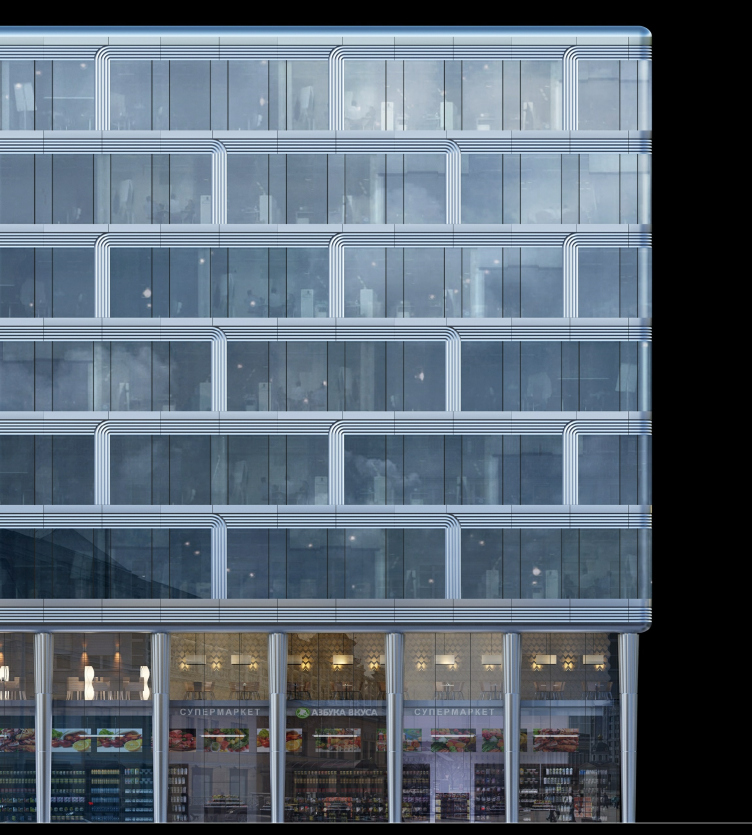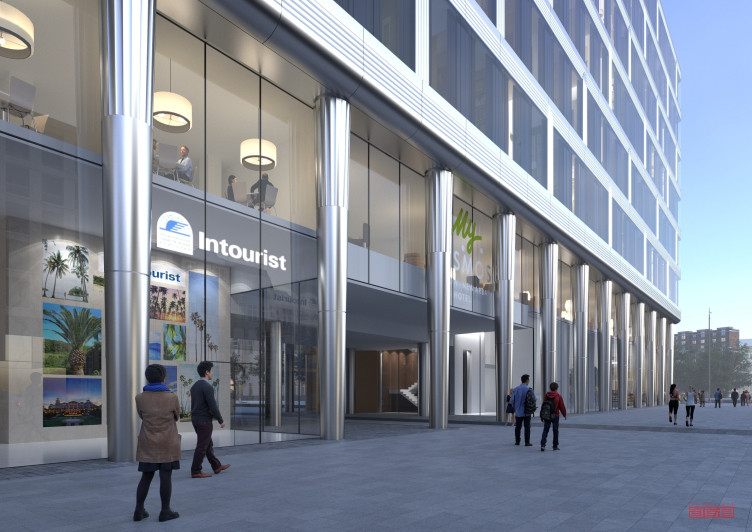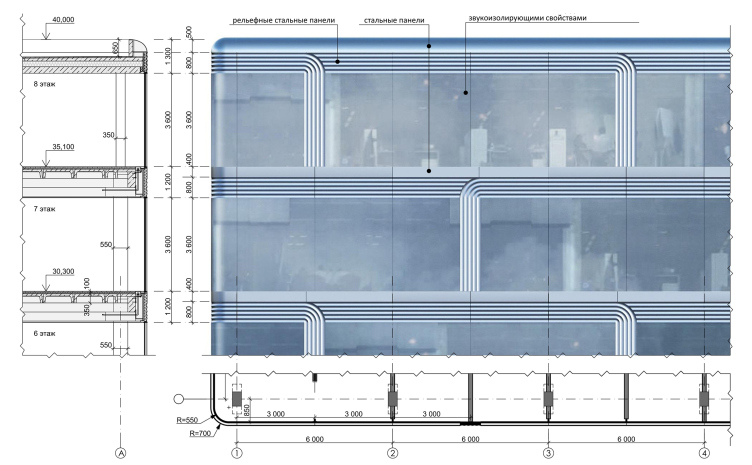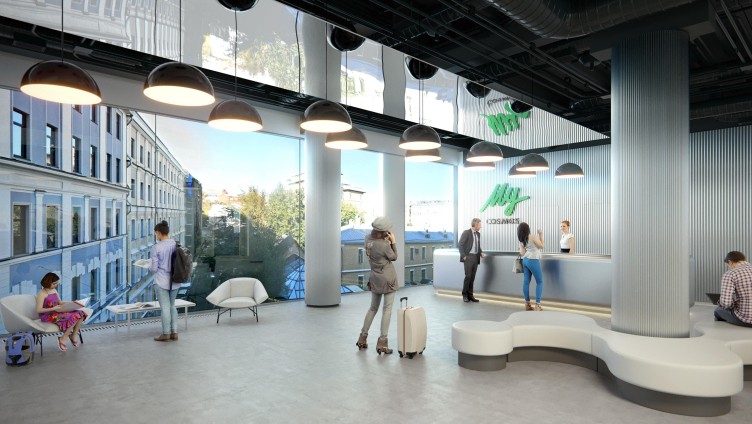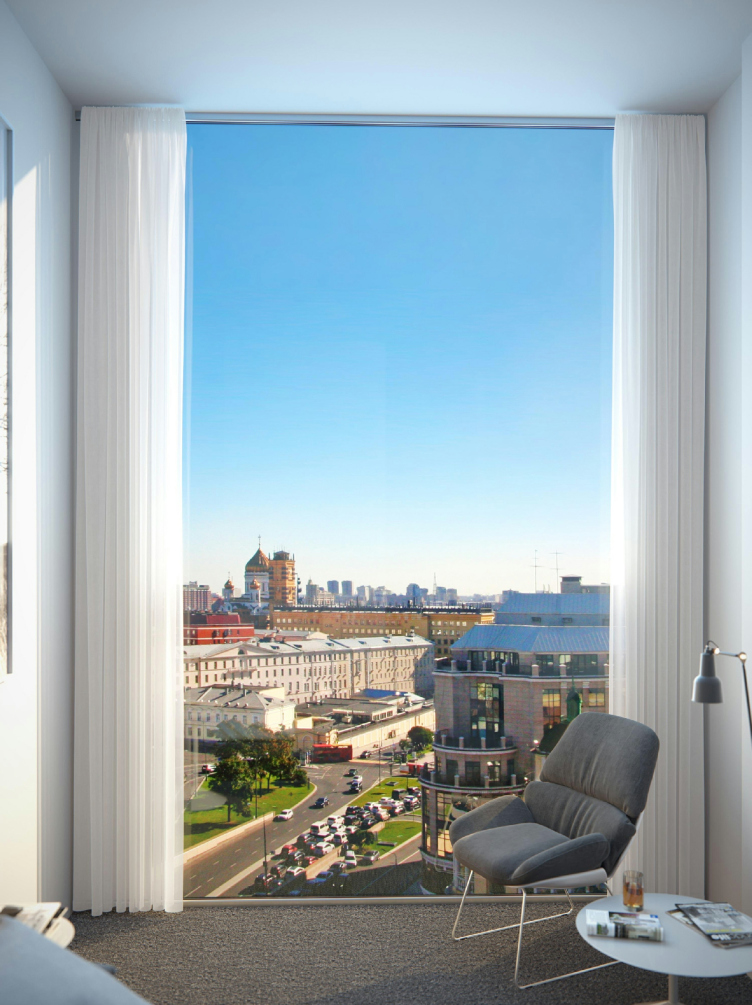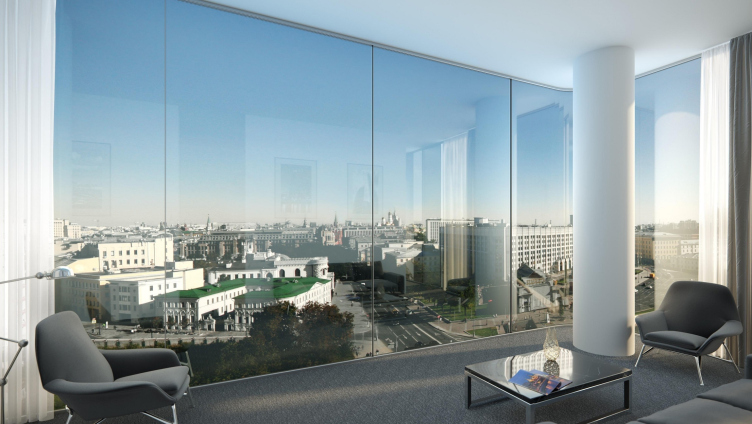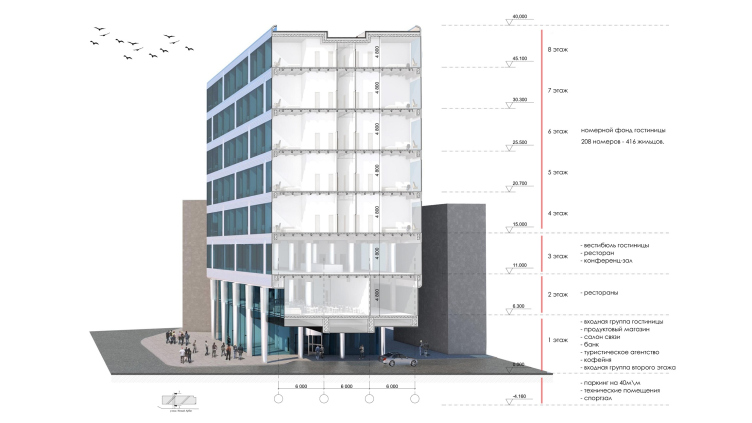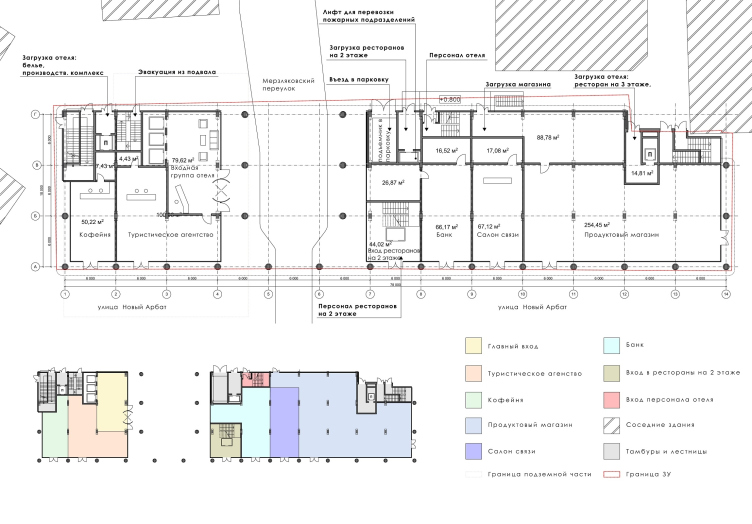The concept proposed by “ABV Group” is one of a whole series of projects connected with the program of reconstructing the buildings of Moscow’s automatic telephone stations that have fallen into disuse after the “fourth industrial revolution” brought about digital standards of communication, and the floor space, which was necessary for communication equipment, shrank not just by tens but by hundreds of times.
Meanwhile, the reconstructed building occupies a rather high-profile place in the city: it is situated in the very beginning of the New Arbat Street, on the corner of the Gogolevsky Boulevard, as a pendant to the Praga Restaurant situated in the beginning of the Old Arbat – just as it occupies a prominent place in the history of the nation’s capital modernism: it was built in 1965 by the team of Studio 23 of Mosproject-1 under the supervision of Victor Egerev as the “Communication House”, and it hosted the proverbial Lenin’s “post, telegraph, and telephone”, or, more precisely, in addition to the automatic telephone station it also hosted a telegraph, and a domestic long distance communication office, occupying, thanks to its versatility, a well-deserved central position in the city. Looking not so much like a telephone station but more like some Soviet research institute, in the late 1990’s the narrow seven-floor slab with laconic ribbon windows and strokes of metallic lamellae got a granite coverage of the first-tier pillars with a characteristic postmodernist little arch, while in the late 2000’s the façade became more and more often covered with a giant canvas of media screen, and now it is generally perceived as one enormous billboard that opens up the New Arbat. However, back in the day it was the contemporary of the construction and the propylaea of the Kalininsky Avenue, the proverbial “false jaw of Moscow” that generated so much controversy, satiric songs, and even became to a large extent, I would say, the catalyst for the development of the contextual city planning method, as well as the movement of the city preservation activists. Meanwhile, this high-profile place, the witness of numerous Soviet movie shoots, the rallies of 1999 and then 2012, keeps on developing: at night, the New Arbat glows almost like Manhattan, and a couple of years ago it got an extra convenience in the form of a long bench that runs in fact all through the avenue – in a word, the street is on the right track. And now the time came to reconstruct the slab standing in the beginning of the avenue – it cannot serve as the prop for a media screen forever.
The architectural concept of the Ihouse Hotel © ABV Group
Copyright: © ABV Group
The architectural concept of the Ihouse Hotel © ABV Group
The architectural firm of Nikita Biryukov proposed a concept of turning the automatic telephone station into a three-star hotel. There are plans for remaking the basement into an underground parking garage, letting the busses drive in here from the direction of the Merzlyakovsky Lane, which runs crosswise to the New Arbat – in fact, this lane runs through the building like a low-ceilinged driveway, which is also narrowed by later-added granite pylons on the sides. The architects clear the pillars and decorate them into glittering metallic, the semitransparent second floor leveling out the squatting profile of the driveway. This way, the space on the lane side gets not exactly a full-fledged yard, but, by contrast with the bustling avenue, the city space is much quieter here, and the passengers will be able to alight right in front of the lobby doors on the ground floor. From the avenue side, the drive-through arch is framed by a broad light marquee that marks its presence in space.
The architectural concept of the Ihouse Hotel © ABV Group
The architectural concept of the Ihouse Hotel © ABV Group
The architectural concept of the Ihouse Hotel © ABV Group
According to the architects, it took them a while to come up with the right façade design solutions – they considered about five different versions including hi-tech and (popular these days) Art Deco ones. As for the source of inspiration for the final version, it was found in the design of the GM Futurliner show bus, the central hero of “Parade of Progress”, a North American traveling exhibition promoting future cars and technologies: the bright streamlined custom vehicle with glittering metallic grooves on the sides that mesmerized America in the 1930’s. But then again, a similar technique – glittering grooves of polished stainless steel – was used by Aleksey Dushkin in his design of the Mayakovskaya metro station back in 1938.
The architectural concept of the Ihouse Hotel © ABV Group
Actually, what was borrowed from the bus was the glittering metal and the grooves. On the façade, the bands of polished steel are bending, connecting the verticals and horizontals into a single entwined whole and presenting a metaphor of printed wire board – a reminder of the technological essence and background of the building, and about the story of how a huge commutator house shrank to the size of a small computer replacement part. At the same time, the IT-related imagery, according to the authors, is also connected to one of the client’s branches of business activity, the Joined-Stock Financial Corporation Sistema; it is also echoed by the name of the hotel – ihouse – let us suppose that this stands for “Intelligent House”. The metallic grooves, however, not only highlight the flexible lines of the metal bands but also remind us of the anti-solar lamellae of the existing building – in the reconstructed version, the host of polished and corrugated bands becomes thinner but it still keeps up the connection with the original building, which is both retrospective and modern at the same time. It looks as though the authors find and sharpen its futuristic features.
On the columns, which unite the first two floors, the grooves come together to form exquisite fluted pillars that take on the role of the capitals that at the same time look like gears, which, in turn, makes perfect sense for the “advanced” technology-generated Art Deco of the 1930’s, as well as for many other versions of modernist architecture, which are always busy trying to find a connection between the modern “mechanical” imagery and the eternal elements of the antique order.
The architectural concept of the Ihouse Hotel © ABV Group
The architectural concept of the Ihouse Hotel © ABV Group
The façades are cleared as much as possible from all the later additions, as well as from original concrete slabs: the intermediate floors are pretty thin, the windows are of the “down-to-the-floor” type, and there is plenty of luxurious light inside, which is beautiful and even slightly surprising for a three-star hotel. On the other hand, the architects did give a thought to ensuring the privacy of the hotel rooms – one can clearly see that transparent windows alternated with blacked out ones that keep the role of a background. The first two floors are 100% glass, with very thin joints and shop windows glowing bright at night.
The architectural concept of the Ihouse Hotel © ABV Group
The architectural concept of the Ihouse Hotel © ABV Group
The architectural concept of the Ihouse Hotel © ABV Group
The architectural concept of the Ihouse Hotel © ABV Group
The architectural concept of the Ihouse Hotel © ABV Group
The architectural concept of the Ihouse Hotel © ABV Group
The architectural concept of the Ihouse Hotel © ABV Group
The architectural concept of the Ihouse Hotel © ABV Group
In the project, the insides of the building are also cleared as much as possible from all the unnecessary things: designed for purely utilitarian purposes, the floor plan of Communication House, of course, could not work for a hotel. The first floor will be occupied by shops, cafes, and the hotel lobby, the second floor will be occupied by offices, while the hotel itself will start off from the third floor where the reception lobby will be situated with hotel rooms going higher up.
The architectural concept of the Ihouse Hotel © ABV Group
None
One must admit that this “retrofuturistic” version of reconstruction will probably indeed be able to liven up the beginning of the New Arbat, a street that was once built as an ostentatiously new one, the newest of the new, which turned it into a subject of heated controversy over the priorities of renewing or preserving the architectural image of the nation’s capital, and now fashionable, noisy to the point of being painful, glittering, and still unique in its own way. Glittering with its polished steel frame, as much as with the lights of its shop windows, yet at the same time keeping up the reserved rhythm, proportions, the shape of the old telephone station, and dating back to the prototypes of the 1930’s, this house becomes quite a decent “right-hand pylon of the propylaea” of the avenue, especially considering the fact that the other pylon here is the building of the Praga Restaurant, which is quite different and neoclassical. In addition, retrofuturism is arguably the hottest trend of today – we have finally been able to realize a lot of things about our dream of the future and understand that rushing headlong without ever looking back is not a really classy thing to do. Maybe it’s all for the best.

